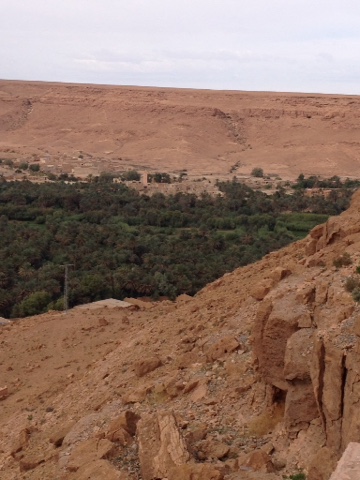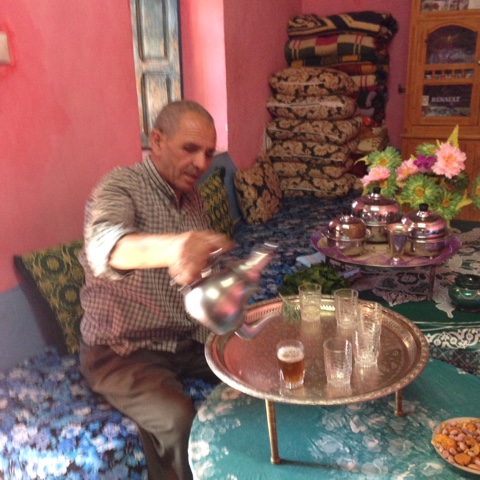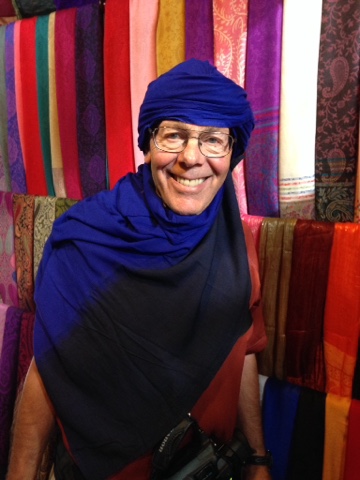Our Arrival in Sudan
Our entry into the capital city of Khartoum was hassle free. A young man from immigration met us as we stepped off the plane and kindly shepherded us through the complicated visa process. This has never happened before. "You are Americans?" he asked, even though we were coming off a plane from Cairo, Egypt. "I will help you," he said, and while we were a little skeptical about his immediate attention, we saw on his badge that he was from Sudanese immigration and most likely legitimate. Even with his facilitation, it took more than hour to complete the visa process. In the meantime, the young man helped Bruce exchange American dollars into Sudanese pounds through the black market at a substantially better rate than we could get at a bank, since no ATMs exist, nor are credit cards accepted. This all took place in the airport men's room, which seemed only slightly seedier than exchanging money with a man wearing an oversized coat on the street in Argentina when we were there last year.
There is a lot of background information that I could provide about how we arranged this trip, and how we were able to get such an exceptional guide named Laura. But there is so much more to tell, so I will save this for another time. Right now I'm exploding with emotion and enthusiasm that I don't want to lose.
For some of you who know me and are also interested in adventure travel, you understand my motives and what drives my fascination with tribal cultures. What I didn't fully appreciate about Sudan was how much tribal exposure we would have. I thought the trip would be mostly to learn about ancient Nubian and Merowe civilizations and to visit archeology sites; and yes, while we did learn about this fascinating history, I did not know how much time we would spend in rural villages and nomadic encampments in the isolated northern desert learning about current culture and life in this harsh land.
The Sufi Dervish Experience
I wrote on Facebook that in Khartoum we would be entertained by the Whirling Dervishes, similar to what we experienced at a caravansary in Turkey, except this time we could take photographs, although we were warned to do so discreetly. What a misperception. This is what happened. Eleven of us, all friends traveling together as we often do, were taken by a small bus out of the hectic city and dropped off in an area that looked like several football fields with different size stones scattered randomly about. In the center of the field was a smallish mosque and there were quite a few people just standing around. Once we focused on the field, we realized that we were standing on the edge of a large cemetery, where the stones represented the deceased in above-ground dirt graves. There were no elaborate headstones like at home, and certainly no flowers to memorialize the dead, but there was no doubt in our minds that we were standing in a very holy place. With my camera hidden deep inside my waist pack, I, along with Bruce and the others, followed a path leading us to a small circle where we found a place to stand close in. Except for the women in our group, the crowd consisted of men wearing their white jillabia, a long dress, which Muslim men often wear, especially on Fridays, which in Islam is the holy day. Also, many wore white turbans and others wrapped their heads in colorful scarves twisted in a very exotic way. The Sudanese women sat together near and up on the ledge of the mosque's wall, separated from the men, but respectfully watching the festivities from afar. Other women, mostly younger mothers, were on the periphery attempting to manage their children in the same way that a Christian mother might do during a service at church.
The Sufi Ritual
I found a good spot on the inner edge of the circle to watch two men chanting, skipping and dancing as they banged on tambourine-like drums, as if playing a game with the audience. They too wore white jillabias and turbans, not black dresses with white underskirts like the Whirling Dervish who perform for tourists in Turkey. These people and the growing crowd around them, ostensibly all Sufi's, were the real deal, engaging in a kind of mystical religious experience. Until they saw us, they weren't expecting any tourists, since this wasn't a show per se, and we were the only non-locals in the crowd, as far as I could tell. These men didn't spin around as if in a trance and attempt to connect with a higher power, at least not in the beginning. Instead they smiled as they sang and made eye contact with anyone who would meet their glance, surprisingly, even me. It was easy to get caught up in the rhythm of the music, the energy of the dance, and the power of being in a holy place among people who smiled at me and laughed with me. I put my right hand over my heart and repeated after them, "Salaam," as I bowed my head in reverence to their devotion. This definitely was the right thing to do because I found myself standing in a key spot right on the inside of the circle. It never occurred to me to feel self conscious. Instead, I was enthralled.
At the same time, my camera, hidden deep within my waist pack, screamed let me out, especially since the Sudanese I saw in the crowd were also taking photos with their smart phones. I took a leap of faith, pulled out my camera and began taking pictures. No one seemed to mind, even the musician/chanters in the circle. Other locals in the crowd entered the circle and pranced around, raising their arms to the sky and chanting something in Arabic that I didn't understand, although I knew the performance was about praising Allah. A disfigured and disabled young man was wheeled to the edge of the circle by his family, and the dancers showed signs of love and affection for the boy as his twisted arms and fingers pointed at them, and he too tried to raise his crippled limbs up to the sky. When an elderly man shuffled into the circle supporting himself with a bamboo cane, several people reached out to help him, and using some sort of inner strength, he managed to move his feet, in sync with the music.
As the dancing continued, the performers signaled for the group to make the circle bigger, and suddenly I felt swallowed up by a surging crowd. I wasn't afraid. I was fascinated. I caught sight of Bruce using his video camera, and saw others in our group with their eyes big and wide, like mine, glued to what was happening in the circle.
Knowing that everyone was all right, I felt more freedom to explore what was going on outside the circle because the deeper the circle, the more difficult it was to see, as people cut in front for a good view. Suddenly the circle broke apart, and almost on cue, a parade of what I would describe as holy men carrying large decorative flags with a large crowd behind them marched in. The chanting increased three-fold in volume, as several more singers stood at microphones placed at the edge of the former circle. I was envious of Bruce's ability to take video because I knew that this was the best way to document the scene. (As he did so well in the YouTube link below.)
The Women
Given that Bruce was strategically placed, I left the crowd and moved closer to the mosque where the women were sitting on the ledge of the wall. They were beautifully dressed in flowing, colorful fabrics of orange, pink and blue, and again I was sticking out like a sore thumb in my khaki pants with a camera hanging from my neck. As I moved closer, they looked me up and down, but then motioned me to join them. That's when I asked a woman if I could take her photo. Smiling, all the time and saying Salaam to make myself approachable seemed to be working. The woman's face lit up by my request, and others seemed more curious about me than what was going on in the circle. Taking photographs of faces, especially faces different from mine, is what I enjoy best. Unlike Morocco, where we had just traveled from, the Sudanese seemed pleased when I asked if I could take their photo. They were proud of their beauty when they saw themselves on my camera's LCD screen. In the background I could hear Sufi music playing, but I was in my own world on the periphery taking pictures of the women.
When I heard someone call my name and saw Laura, our guide, motioning for me to come, I said good-bye to the women around me. They waved their hands, and one woman even hugged me, an unusual gesture for this culture. Expressing myself in the only few Arabic words I know, and with my right hand over my heart, a custom in Sudan, I said Shukraan (thank you) and Ma'a Assalaamah (goodbye). I wished I knew the Arabic words to say how grateful I was to be accepted so openly by them and with such trust.
Please click on this YouTube link entitled Friday Sufi Dervish Ritual, Khartoum, Sudan to see Bruce's two minute video of our experience. You will love it!

















